Final report for LNE13-326
Project Information
Data for the primary study comparing sap yields from spout/dropline replacement and cleaning were collected over the 2014 and 2015 seasons. Technical issues precluded repeating the main study in 2016, however ancillary research data was collected during the 2016 and 2017. In general, replacement strategies (spout replacement, use of Check-valve spouts or adapters, or dropline replacement) produced the highest sap yields and higher net profits (gross profits minus costs of strategy implementation). Cleaning methods produced an intermediate level of net profit. Cleaning with spout replacement resulted in the lowest net profit due to higher costs. None of the chemical sanitizers tested were clearly more advantageous than the others in terms of efficacy, however cleaning results were greatly improved with longer contact time between the sanitizer and the material being cleaned. However, the amount of sanitizer, the time required to complete cleaning, and the necessity to rinse after cleaning meant that most cleaning treatments were frequently not cost-effective when compared to simple replacement strategies. Short-contact time cleaning strategies such as sucking in a small amount of sanitizer under vacuum were considerably less effective due to inadequate sanitizer contact time, therefore producing reduced yields and lower net profit.
Throughout the course of this project, a total of 124 individual presentations were conducted within the NESARE region, resulting in 4,815 producer contacts (including repeat attendees), and 152 hours of instruction into methods to improve sanitation of maple tubing systems and achieve higher net profits. In addition, eight individual publications were made in maple producer journals or newsletters, and a video was produced.
Although not part of the original project, the introduction and adoption of 3/16″ tubing during the time of the project period resulted in the investigators doing additional research work to examine the effects of sanitation practices with this tubing and communicate those results to maple producers. This research builds upon and extends the NESARE sanitation study. Early results indicate that 3/16″ tubing is more susceptible to sanitation-induced sap yield losses over time. Work to determine the most appropriate remediation approach in 3/16″ tubing systems is still ongoing.
Introduction:
Sanitation is a critically important component of achieving high yields from maple trees. A multi-year field study across two sites (NY and VT) was used to examine the impact of various replacement and cleaning strategies of spouts and droplines on sap yield and net profit (gross profit from sap collected minus the cost of implementing the sanitation strategy) and to recommend approaches maple producers could take to achieve their desired objective. The information gained in this study was communicated to maple producers via presentations at meetings and conferences, through publications in maple industry journals and newsletters, and in an online video. A majority of producers adopted one or more recommended strategy to increase their sap yields and net profits.
Annual sap yields in most maple operations are reduced by 10% or more annually due to microbial contamination of the tubing collection system (1). Microbes present in the system infect the new taphole and accelerate the rate of taphole drying, the slowdown and cessation of sapflow (2). Consequently, these yield losses result in significant reductions in net profits of maple operations. To counter taphole drying, maple producers employ two general types of sanitation strategies: cleaning/sanitizing the tubing system after each production season, or annual replacement of various parts of the tubing and spout system.
Replacement strategies are aimed at improving sanitation in the immediate vicinity of the taphole by replacing system components such as spouts or droplines. This has been shown to result in sap yield and net profit increases ranging from $1.02 to $3.09 per tap (3-5). Cleaning/sanitizing (“cleaning”) strategies are aimed at reducing microbial populations throughout the tubing system by washing, which is attempted through a variety of methods (such as pressurized air and water rinsing), and/or by rinsing the system with food-grade sanitizers such as bleach or alcohol. However, the effectiveness, if any, of cleaning strategies in bolstering sap yields and net profits is unknown.
A 2011 survey of 178 maple producers conducted by UVM PMRC indicates that 89% of producers in New England and New York with operations of all sizes annually clean their tubing systems (6). However, it is possible that many of the currently used cleaning strategies either do not result in profit increases comparable to those of replacement strategies, or may even actually result in net profit losses (due to cost of materials and labor required to clean). Thus many producers – up to 89% of the over 4,000 producers who tap 7.8 million trees in NE/NY (7,8) – are likely not using a strategy that successfully combats yield losses from microbial contamination and results in the best possible outcome (the largest increase in annual profits). This means that the majority of maple producers could significantly increase their net profits, by at least $1-3 per tap annually, by adopting a more beneficial strategy.
On a total of 850,000 tapped trees, 450 maple producers adopt a more beneficial practice to combat sap yield losses from microbial contamination, resulting in an increase in annual net profits of $1 to $3 per tap.
Over 75% of producers who attended a presentation indicated they had, or planned to adopt one or more of the recommended practices to improve yields and net profits. This represents an improvement of yields on a minimum of over 3 million taps across the NESARE region (assuming each producer attended two sessions), with an estimated minimum net profit increase to producers of $1.2-7.0 million annually for maple producers in the served area.
Cooperators
- (Educator and Researcher)
- (Educator and Researcher)
- (Educator and Researcher)
Research
Replacement and cleaning strategies will increase sap yields that are otherwise lowered due to microbial contamination of maple tubing systems, resulting in increases in net profits per tap for maple producers.
We conducted experiments in two field sites (NY and VT) over two seasons (2014 and 2015) to compare the volume of sap produced from tubing systems treated with each of nine treatments. The replacement strategy treatments chosen for the experiment were identified by producers as those methods most commonly used in the maple industry which have been demonstrated through previous research to result in net profit increases (4,9). The four cleaning treatments were also those identified by producers as common methods, and were further selected through laboratory pilot studies that determined which of the numerous methods maple producers currently utilize (identified through producer surveys (6)) are the most effective at reducing microbial contamination. The treatments included rinsing with water, bleach, isopropyl alcohol, and hydrogen peroxide. The final treatment combined a cleaning treatment (the most promising based upon pilot studies) and Replacement Treatment 3 (used dropline with new standard maple spout) to assess the interactive effect of these approaches.
Treatments selected for field testing included:
• Control (no replacement or cleaning) = Used and uncleaned dropline with used spout
• Replacement Treatment 1 = new dropline with new standard maple spout
• Replacement Treatment 2 = used dropline with Check-Valve spout
• Replacement Treatment 3 = used dropline with new standard maple spout
• Cleaning Treatment 1 (bleach)
• Cleaning Treatment 2 (hydrogen peroxide)
• Cleaning Treatment 3 (isopropyl alcohol)
• Cleaning Treatment 4 (water)
• Replacement + Cleaning Treatment
We compared sap yields, costs of strategy implementation, and net profits achieved with each of the methods.
Thirty-six experimental field “lines” were established at both the University of Vermont Proctor Maple Research Center in Underhill Center, VT, and at the Cornell University Arnot Forest in Van Etten, NY, with relatively uniform tree and tubing system properties. Each “line” consisted of three-to-five trees (one tap per tree) connected via droplines and lateral lines to a 20 gallon sap collection canister. Treatments (including the no-treatment control) were assigned randomly to four replicate plots. Vacuum was supplied to each sap collection canister using a liquid ring piston pump (UVM) at ~25" Hg or a rotary vane pump (Cornell) at ~19" Hg. Sap yield from each canister was measured after each sap flow period and totaled for each season. Prior to the 2014 and 2015 maple production seasons, each line was treated with its assigned treatment (cleaned, components replaced, or a combination of cleaning and replacement). At UVM, the cleaning treatments were done in situ, with sanitizing solutions pulled in under vacuum to replicate the procedures used by larger producers. At Cornell, the droplines were cleaned in the lab by immersion prior to the 2014 season, and cleaned by flooding the entire system with sanitizing solution prior to the 2015 season. This approach resulted in a longer contact time for the droplines with the sanitizing solution and was expected to produce a higher sanitizing efficacy.
During the 2014 and 2015 production seasons, sap was collected and measured from each line after each sap flow period in order to determine the total volume of sap produced by each line, and the average total volume produced by each treatment. These data were used to calculate any increase in sap yield resulting from the application of each treatment relative to the no-treatment control.
For 2014-2016, additional studies using the treatments were conducted at the UVM site using individual tree chambers to verify the results observed in the larger study. In these studies, 10 replicate trees were used per treatment for a total of 110 trees. Vacuum was supplied by a liquid ring pump running at 25" Hg, and sap was measured after each flow period and totaled for the season for each treatment.
The total cost per tap of implementing each treatment, including time and labor, materials, and waste disposal/recycling, was calculated. Together with the sap yield data, we calculated the average net cost and average net profit per tap of each of the sanitation strategies used to combat sap yield losses from microbial contamination.
Additional supporting data was collected from 2 on-farm cooperators in NY. Both farmers tested sanitizing drops removed from the woods with subsequent deployment back into the woods.
Because a new type of tubing (3/16) appeared during the course of this project, studies on sanitation approaches in this type of tubing using methodologies similar to that described were initiated at both the UVM and Cornell Sites. Because it takes several years for tubing to become fully impacted by sanitation-related issues, this work continues.
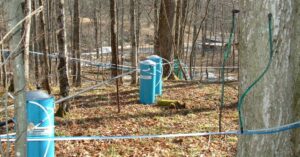
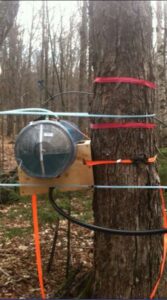
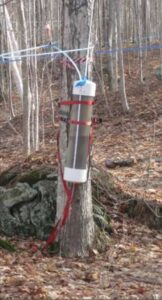
Based upon these results, replacement strategies (new spouts, use of CV spouts or adapters, regular dropline replacement) tended to produce the highest sap yields and highest net profits. Cleaning strategies were typically somewhat less effective, however this varied depending upon the cleaning technique used. Short contact-time cleaning, such as that studied by UVM and practiced by larger maple producers, although it produced some modest gain in sap yield, was considerably less effective than long contact-time cleaning examined by Cornell. Long-contact time cleaning was typically more costly due to higher volume of sanitizer used and time (labor) required, and thus, while it results in high sap yields, produced somewhat lower net profits. In addition, all sanitizers examined required producers to either flush the tubing after application, or to allow the first sap flow to run on the ground to rinse out any residual cleaner. There is considerable resistance among producers to this practice.
Beneficiaries learned the importance of achieving proper spout and dropline sanitation in achieving high sap yields, the types of spout and dropline sanitation strategies currently available, and the effects of each strategy on sap yield improvement and net profit in their maple operations.
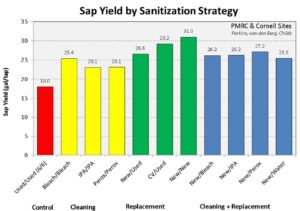
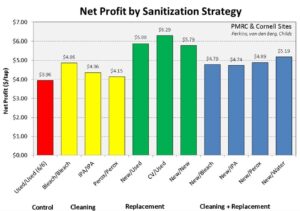
Outcomes
From 2014-2017 we determined the effect of different sanitation strategies (replacement, cleaning, or cleaning plus replacement) on maple sap yield, cost of implementation, and net profit on a per tap basis. The results are quite clear that the highest net profits are typically gained through replacement strategies, that cleaning produces a somewhat lower net profit, and that a combined cleaning plus replacement strategy produces the least net profit. Clearly any type of sanitation strategy was better than no sanitation at all. The various sanitation strategies produced a range of net profits from $0.39-2.33. When cleaning with sanitizers is used, longer contact times are necessary to increase efficacy of microbial kill. In some cases when sap yields are low (gravity collection), some sanitation strategies can result in negative net profits. However, because maple producers may have other reasons for adopting a particular approach, we presented the range of options investigated so that individual producers could make a more informed decision on how different sanitation strategies might affect their bottom line.
Over 4,800 maple producers from across the NESARE region attended presentations describing the results of this project since its inception. Adoption of improved sanitation strategies is nearly ubiquitous across the maple industry, with the result that sap yields across the maple producing area strongly increased over the time period of this project.
Additional work beyond this project is examining the same type of relationships among sanitation, sap yield, and net profit in 3/16″ maple tubing. Some aspects of this work continues to determine the most appropriate sanitizing remediation strategy in 3/16″ tubing systems.
Various replacement and cleaning strategies result in differing levels of improvement in sap yield and net profit.
Replacement strategies are typically more cost-effective (produce a higher net profit) than cleaning strategies.
Cleaning is more effective with increased contact times. Cleaning in place (CIP) by sucking sanitizer in under vacuum is far less effective than soaking or flooding.
Cleaning in low yield operations can often result in negative net profits.
The longer the season, the more “impact” any sanitation or replacement strategy has on sap yield.
Maple producers should select a strategy that fits their needs and results in the highest net profits for their operation.
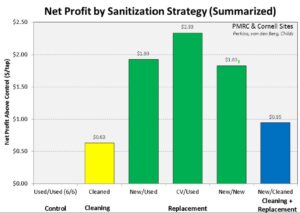
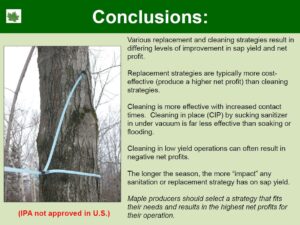
Education
Education was primarily accomplished through presentation of results to producers and industry professionals at maple conferences, manufacturer open houses, and other maple producer meetings and through publication of results in maple industry literature. In addition, a video of one of the presentations was made available to producers. A summary report is currently in preparation, with availability to be announced this spring in upcoming editions of the "Maple News" and "Maple Syrup Digest" and at Open Houses in the spring after the 2018 sugaring season. The report will be accompanied by an updated version of an Microsoft Excel-based spreadsheet tool for maple producers to use to estimate the effects of different strategies on sap yield and net profit in their own sugaring operations.
Milestones
Four thousand maple producers learn about the project through an announcement distributed to members of producer organizations and forums in the project area, and receive a link to an online survey. (Oct ’13 – May ‘14)
4000
14000
May 31, 2014
Completed
October 31, 2017
Maple producers were informed of this project through announcements in the Maple Syrup Digest (a publication of the North American Maple Syrup Council), the Maple News (a periodical/newspaper reaching approximately 90% of all taps in the U.S.), and via two online maple forums, MapleTrader.com with 14,806 members and Sugarbush.info with 3,271 members. In total we estimate that at least 80% of producers in NESARE served states were exposed to the announcement.
Fifteen hundred of these producers complete the online survey about their current practices and knowledge, and their intention to participate in the education program.
1500
1695
Completed
May 31, 2014
Maple producers in the NESARE and outside areas were invited to participate in a sanitation survey to assess current methods employed to achieve spout/dropline sanitation. Announcements were made in the "Maple Syrup Digest", the "Maple News", through requests of individual state maple associations, and online via MapleTrader.com and Sugarbush.info
1,695 NESARE state participants participated (74.9% of all respondents) in the survey. These represented a wide variety of current sanitation practices and operation sizes. Over 97% of those indicated interest in research and education on the subject of maple spout and tubing sanitation and how it impacts sap yield and profitability.
Most indicated a preference for receiving educational information in the form of a presentation at a maple meeting, in a "Maple Syrup Digest" or "Maple News" article, or via online discussion forums. Nearly all indicated a willingness to adopt new strategies that proved to increase sap yields and profitability.
Nine hundred of these producers participate in the project’s education program by attending a local presentation, webinar, or viewing the presentation online, where they learn about the project and its performance target, the net profits gained through cleaning and replacement sanitation strategies, how to best implement these strategies in their operations, and other best practices for maximizing sap yields in their operations. (June ’14 – Feb ’15)
900
4816
February 28, 2015
Completed
October 31, 2017
Presentations by project investigators resulted in a total of 4,816 contacts in 131 meetings with maple producers in the NESARE region. Some of these were undoubtedly repeat participants.
In addition, other media (publications, videos, newsletters) reinforced the educational outreach to these producers and others who had not attended maple conferences or meetings.
Spout-and-Tubing-Sanitation-2018 NESARE-LNE13-326-Publications
Recording of Conference Presentation
Spout-and-Tubing-Sanitation-Presentation-2018
NESARE-LNE13-326-Meetings-Summary
Seventy-five % of producers polled during presentations indicated they had adopted or intended to adopt a recommended sanitation practice. Given that the recommended practices produced an estimated additional net profit of $0.39-2.33/tap, with average maple operations having 2,800 taps, this equates to an added profit of $1.17-7.0 million annually for participating maple producers across the NESARE region. Completed October 2017.
Six hundred and seventy-five of these producers complete an online survey and communicate to the project team whether they intend to adopt a different sanitation practice; they also receive a data collection template, one -on-one assistance if needed, and a link to the online survey to be used after the production season for performance target verification. (June ’14 – Feb ’15)
675
In Progress
Accomplishment of this milestone has been delayed. A summary publication and spreadsheet for calculating/estimating the results of changes in practice on yield and net profit is being made made available to maple producers. When the publication and spreadsheet tool are publicly released, we will begin collection of survey results to assess this outcome.
It is clear from USDA NASS data that maple producers in the NESARE region have been adopting improved sap collection strategies (primarily sanitation-related) throughout the course of this project. Syrup yields have increased 20.4% within the NESARE region during the course of this project (2014-2017) compared to the timespan immediately preceding this project (2010-2013). Outside the NESARE region, yields have only increased 10.3%, although maple producers outside the NESARE area have also likely benefitted from this project, but not nearly to the same extent due to the concentration of educational efforts within the NESARE zone. Increased yields results in increased productivity, thus growth in maple production also occurred much more briskly within the NESARE region (44.1%) than outside (14.5%). The result is that the total maple crop value has increased within the NESARE region by 38.2% over the past several years, compared to a growth of only 10.2% in non-NESARE states. In total, NESARE states increased their maple crop value by $33M during the project period compared to a $1.6M change in value for non-NESARE states.
Project investigators have had hundreds of in-person and online interactions/consultations with producers to discuss sanitation approaches and improvements. This effort continues with numerous inquiries on a monthly basis.
Five hundred of these producers document their change in net profits following adoption of a more beneficial cleaning or replacement strategy by submitting completed verification information to the project team. (May ’15 – Sept ’16)
500
In Progress
As above, this milestone has not been completed due to the delay in release of the summary publication and spreadsheet tool. A draft of the tool is attached.
After release, documentation of changes in net yield and net profit for participating maple producers will be conducted.
Milestone Activities and Participation Summary
Educational activities:
Participation Summary:
Learning Outcomes
Maple producers were polled near the end of some presentations to estimate the number of attendees at presentations who had, or planned to change spout and tubing sanitation practices based upon information conveyed during the session. In all cases, 75% or more indicated affirmatively.
Performance Target Outcomes
Target #1
450
Maple producers adopt a beneficial practice to combat sap yield losses from microbial contamination.
850,000 taps
Maple producers will experience an increase in annual net profits of $1 to $3 per tap.
1800
Producers made or intended to adopt recommended spout/dropline sanitation practices to improve sap yields and profits.
Based upon the average maple operation size of 2,800 taps, attendance of 2,400 producers at presentations, average net profit rates due to improved sanitation, and 75% of polled respondents answering affirmatively that they had or intended to use recommended practices, we estimate over 5 million taps production was affected, with $1.1-7.0 million in additional annual revenue from maple production for producers in the NESARE region.
We estimate $1.1-7.0 million in additional annual revenue from maple production for producers in the NESARE region due to improved sanitation practices.
Target #2
Outcome data were verified by verbally polling participants during presentations made during the last year of the project. In all cases, 75% or more of attendees indicated that they had implemented, or planned to implement, recommendations on improving sanitation strategies to improve sap yields. Extrapolating these results to the attendees of all presentations produces the result that 1,800 maple producers utilized this information to improve their operations. Given the average size of maple operations in the NESARE region (2,800 taps), and the range in net profit increase across all sanitation strategies ($0.39-2.33), this project is estimated to have produced between $1.1-6.0 million in additional annual net income for affected maple producers in the NESARE region.
Verification is somewhat complicated by the fact that maple producers were already rapidly adopting replacement strategies throughout the course of this project based upon our prior research and on the recommendations of maple equipment dealers. The benefits of adoption were so apparent and so large that the change happened very quickly.
The final maple industry publication and associated Excel tool is in preparation for release in the "Maple Digest" and "The Maple News" in the spring of 2018. This was delayed in part due to illness of the PI.
Additional Project Outcomes
Funding from the North American Maple Syrup Council for two related projects investigated methods of tubing cleaning and the utility of tapping below the lateral line (inverted dropline). The tubing cleaning study examined a broad range of cleaning methods and sanitizers, and was used to help select the most appropriate sanitizers for the NESARE project. The inverted dropline study showed that tapping below the lateral line is effective in terms of being able to access non-compartmentalized wood if both good vacuum and good sanitation practices were employed.
USDA Hatch funding was used to examine sanitation-related losses in sap yield in 3/16" tubing over time and possible remediation strategies. To date we have determined that 3/16" tubing systems appear to be more susceptible to sap yield losses due to sanitation-induced aging. We are currently still investigating the appropriate strategies to limit these losses, and continuing with educational efforts to disseminate research previous and ongoing results.
The experimental approach for monitoring sap yields using vacuum chambers to assess various sanitation treatments worked out very well and is likely to serve as the basis for future studies.
Information Products
- 2018 Cornell Spout Sanitation Tests Using 3-16 inch tubing
- Check-valve vs standard spouts
- Cornell Sanitation 2017
- Do Not Use Isopropyl Alcohol as a Maple Sanitizer in the U.S.
- How often should you replace droplines?
- Spout and Drop Sanitation for High Yield Production
- Assessing Strategies for Spout and Drop Sanitation in 5/16” Tubing: Sap Yield, Cost, and Net Profit
- Sanitation Model
- Should droplines be replaced when using check valve adapters or spouts?
- Taphole sanitation research in the 2017 season
- Taphole sanitation results over time with 5/16” tubing
- New York State Maple Tubing and Vacuum System Notebook, 6th Edition